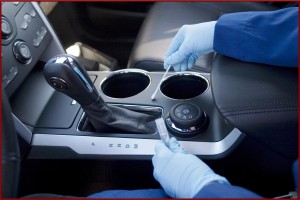
Cars and trucks can become a breedingplace for a variety of microorganisms that cause odors and discoloration of vehicle surfaces. A billion-dollar air freshener business is built from this.
Ford Motor Company and University of Michigan researchers are studying microbes in automobiles that infest interior surfaces causing discoloration and odors. Ford wants to know where microorganisms grow to develop antimicrobial additives for its coatings.
Ford employees took swabs from ten locations in vehicle interiors, including the steering wheel, radio buttons, door handles, window switches and gear shift knobs, which were then cultured and analyzed at a U-M laboratory in Ann Arbor, Michigan.
U-M researchers found significant bacteria growth at most of the test locations, with the highest concentrations evident on the steering wheel and the area around the cupholders.
“Our findings suggest car interiors are complex ecosystems that house trillions of diverse microorganisms interacting with each other, with humans, and with their environment,” said Dr. Blaise Boles, assistant professor in the U-M Department of Molecular, Cellular and Developmental Biology.
“The long-term goal is to define the microbial ecology of the car interior and to optimize the design of car interiors to promote comfort and environmental sustainability,” Boles said.
More than $1 billion annually is spent in the U.S. on a variety of products including lotions, wipes and sprays to fight microbial growth, according to Ford. Since Ford now knows the source of the microbes in auto interiors, it is working with interior coatings supplier Red Spot Paint and additive supplier Sciessent to develop and test coating formulations that could resist and even reverse microbial growth.
Three commonly used and EPA-approved antimicrobial additives are under study: silver-ion, ammonium salt and polyolefin wax with a nano-silver coating. Panels painted with four different formulations were then sent to the U-M lab to assess the growth rates of microorganisms.
Parts coated with paint infused with the silver-ion additive sold under the trade name Agion, contained lower microbe growth than the control parts with the current Ford production paint. Agion, based on elemental ions, works by starving, sterilizing and suffocating the microbes to prevent them from growing and reproducing.
Cars and trucks have a much longer life span than most antimicrobial-treated products, and they operate in a wider range of environmental conditions. Ford subjected the specially coated test panels to an accelerated aging process to evaluate their microbe-controlling properties after the equivalent of years of exposure to sun and heat.
Even after simulating many years of use, the microbe growth of the Agion-infused coating changed very little. The additive also had little impact on the gloss and color change of the surfaces over the test period. Parts with the antimicrobial-treated coating are now undergoing real-world testing in a number of Ford development vehicles, and the coating is being evaluated for potential use in future Ford vehicle programs.

